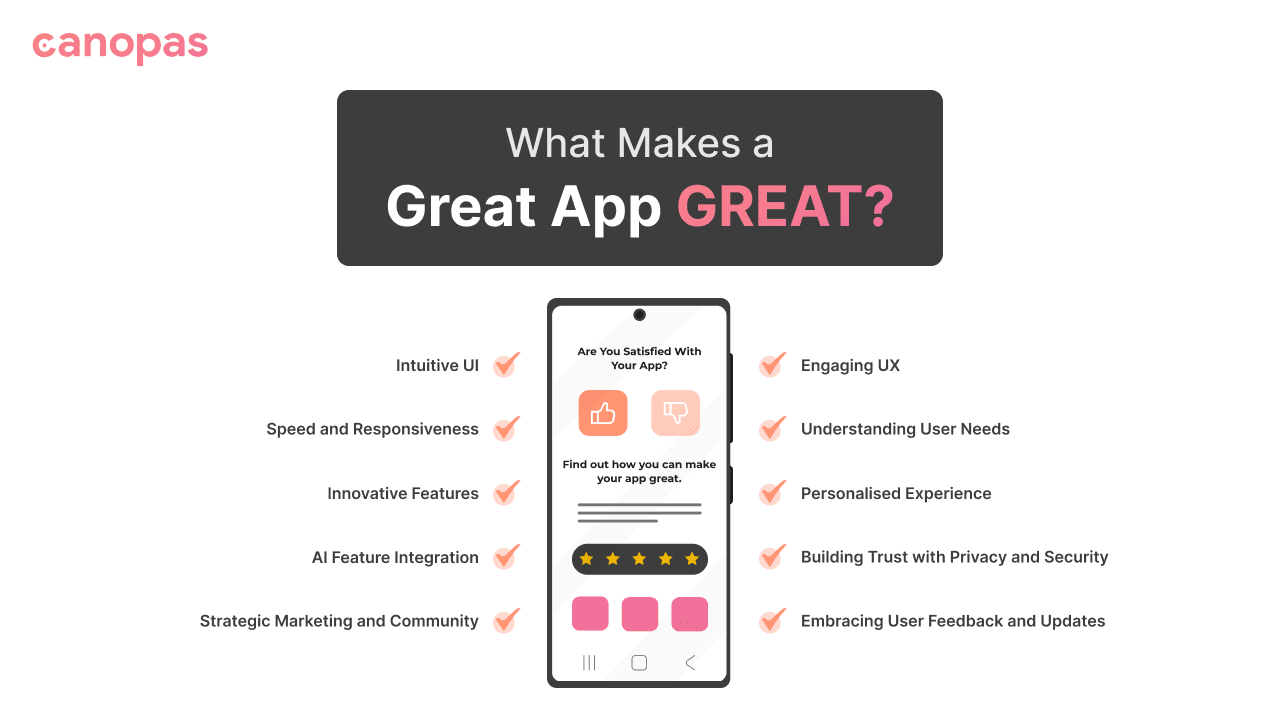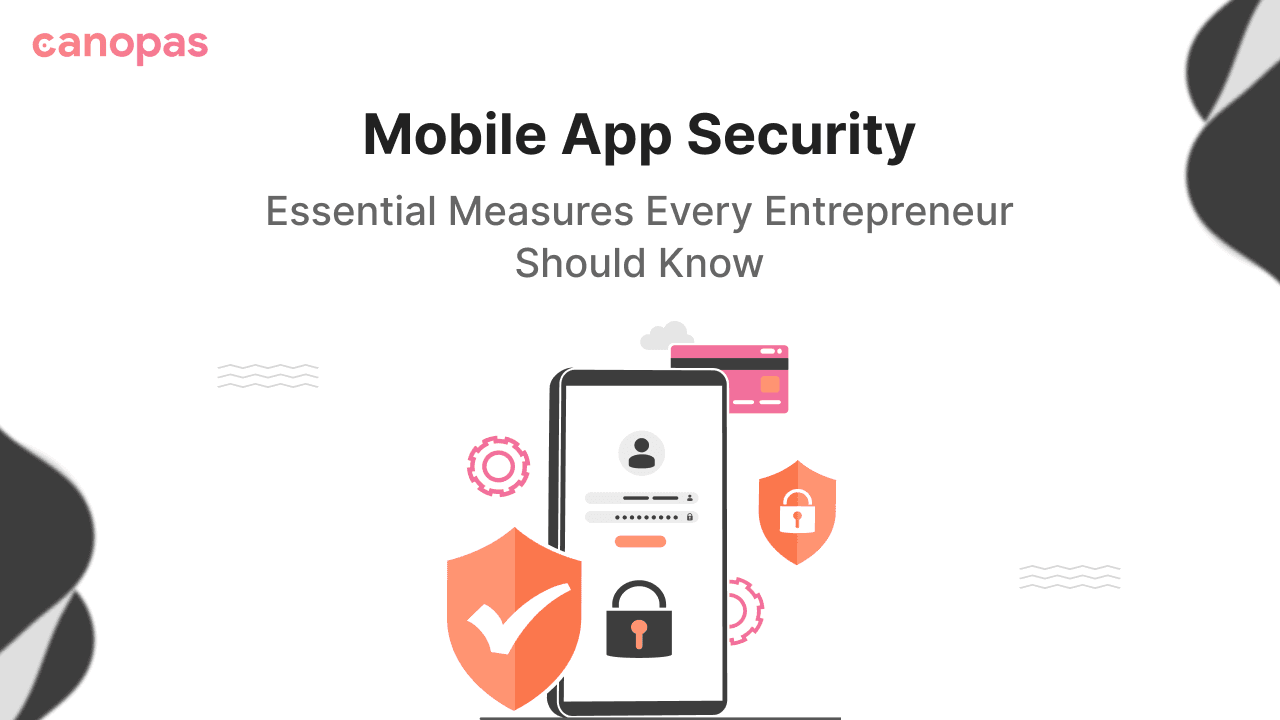
What Makes a Great App Great?
Unraveling the Secrets of Successful Apps
Have you ever wondered what makes great apps truly great?
It’s a question that not only intrigues app enthusiasts but also stands as a crucial puzzle for developers and business owners in the digital realm.
If you have used any of the apps like WhatsApp, Airbnb, Spotify, etc. then you might know that they deliver very unique experience compared to other apps.
In this exploration, we delve into the anatomy of successful mobile applications, uncovering the core elements that elevate an app from being just functional to truly phenomenal.
From the sleek and intuitive designs that captivate users at first glance to the innovative functionalities that keep them engaged, the journey to app greatness is a blend of art, technology, and user psychology.
Whether you're an aspiring app developer, a business owner looking to expand into the digital space, or simply curious about the magic behind your favorite apps, this blog aims to demystify the attributes that make an app not just functional, but great. Join us as we embark on this exploration of app excellence.
User Centric Design
When you embark on the journey of app development, the design is not just about aesthetics; it's about creating an experience that resonates with your users.
Here’s why user-centric design is pivotal in making your app stand out and how you can do it for your app.
Intuitive User Interface (UI)
- First Impressions Matter: The UI is often the first point of contact between your app and its users. An intuitive and aesthetically pleasing interface can make a lasting first impression.
- Ease of Navigation: Users should find what they need without hassle. A well-designed UI guides users fluidly through the app, making their experience smooth and enjoyable.
Engaging User Experience (UX)
- Meeting User Expectations: Your app should not only look good but also feel good. Users expect a seamless interaction, whether they are shopping, booking a service, or playing a game.
- Consistency is Key: Consistent design elements across the app enhance usability and reduce the learning curve for users.
Case Study: A Closer Look at a Winning UI/UX
- Consider an app like Spotify, renowned for its exceptional UI/UX. Notice how Spotify simplifies the process of finding and playing music, presents information cleanly, and guides users with intuitive navigation. Its success lies in how effortlessly users can explore new music, curate playlists, and navigate their vast library – all testament to its user-centric design approach.
As an individual diving into app development, always keep your end-users in mind. Their experiences, preferences, and ease of use should be at the forefront of your design process.
By doing so, you not only meet their needs but also create an environment in which they enjoy spending time, and that is a significant first step towards app greatness.
In the next section, we’ll explore the nuts and bolts of what makes an app not just look good but perform seamlessly – the crucial interplay of functionality and performance.
Functionality and Performance — The Backbone of Your App
An app’s success is deeply rooted in how well it performs and how effectively it functions. This is where the technical prowess of your app comes into play. Let’s break down why functionality and performance are non-negotiable in creating a great app.
Reliability: The Core of Functionality
- Consistent Performance: Your app needs to work flawlessly every time. Users have little patience for frequent crashes or bugs.
- Efficient Error Handling: When issues do occur, the app should handle them gracefully, providing users with clear information and reassurance.
Speed and Responsiveness: Catering to the Need for Speed
- Quick Load Times: In an era of instant gratification, your app needs to load quickly and respond promptly to user inputs.
- Smooth Interactions: Whether it’s scrolling through a feed or processing a payment, every action should be smooth and free from lag.
Compatibility: Bridging Different Devices and Platforms
- Cross-Device Functionality: Ensure that your app provides a consistent experience across various devices and screen sizes.
- Platform Considerations: Be mindful of the differences between operating systems like iOS and Android. Your app should be optimized for the nuances of each platform.
A Real-World Example: The Efficiency of Google Maps
- Take an app like Google Maps as an example. It stands out for its reliable performance, quick loading of maps and routes, and smooth user interactions across a variety of devices and platforms. This level of performance is a significant reason behind its widespread adoption and user reliance.
As you develop your app, remember that the functionality and performance are what will keep your users engaged and satisfied.
It's not just about what your app does, but how well it does it.
Ensuring that your app works reliably, quickly, and across platforms is fundamental in turning your app idea into a great one.
In the upcoming section, we’ll explore how addressing real user problems and providing innovative solutions sets the foundation for a successful app.
Solving Real Problems — The Heart of App Innovation
At the core of every great app is its ability to solve a real problem or improve an existing solution. This is where innovation and understanding of user needs become pivotal.
Let’s explore how addressing real-world problems can propel your app to greatness.
Identifying and Understanding User Needs
- User-Centric Approach: Begin by identifying a problem or need that is significant to your target users. This requires thorough market research and user empathy.
- Feedback Loops: Engage with potential users early and often to refine your understanding of the problem and validate your proposed solutions.
Offering Innovative Solutions
- Creative Problem-Solving: Sometimes, the best app solutions are those that approach a problem in an entirely new way.
- Simplicity in Solution: Great solutions are often simple and direct. The goal is to solve the problem efficiently without unnecessary complexity.
Case Study: Transforming Communication with WhatsApp
- Consider WhatsApp as a prime example. It addressed a simple yet widespread need for easy, cost-effective communication. By offering free messaging, voice, and video calls over the internet, WhatsApp revolutionized how people connect globally, particularly in areas where traditional SMS and call costs were prohibitive.
Adapting and Evolving
- Staying Relevant: The best solutions are adaptable to changing user needs and technological advancements.
- Continuous Improvement: Regularly update your app based on user feedback and emerging trends to keep it relevant and useful.
As you work on your app, remember that its success hinges on how well it addresses a real problem for your users. Innovative solutions that resonate with user needs can set your app apart in a crowded marketplace.
Your aim should be to not only solve the problem but to do so in a way that is intuitive, efficient, and perhaps even enjoyable for the user.
Next, we will delve into the world of unique and rich features, exploring how they add value to your app and enhance user engagement.
Adding Value with Unique and Rich Features
In a market brimming with apps for every conceivable purpose, standing out often boils down to the unique and compelling features your app offers. These features not only attract users but also play a crucial role in retaining them. Here’s how you can add value through distinctive features.
Innovative Features: Breaking the Mold
- Think Outside the Box: Innovation doesn't always mean reinventing the wheel. Sometimes, it's about offering a new spin on existing features or presenting them in a way that enhances user experience.
- Solving Problems Creatively: Focus on features that solve user problems in ways they might not have expected.
Regular Updates: Keeping the App Fresh
- Evolving with User Needs: Regular updates show users that you are committed to improving their experience and adapting to changing needs.
- Introducing New Features: Use updates as an opportunity to introduce new features based on user feedback and market research.
Spotlight on Feature-Rich Success: The Evolution of Instagram
- Consider the evolution of Instagram. It started as a simple photo-sharing app but has since added numerous features like Stories, Reels, IGTV, and Shopping. These features kept the platform relevant and engaging, continually attracting and retaining users.
User-Centric Feature Development
- Feedback-Driven Improvements: Engage with your user community to determine which features they value the most and which ones they feel are missing.
- Prioritize User Benefit: Every new feature should add tangible value to the user experience, whether it’s increased convenience, entertainment, or functionality.
As you develop your app, remember that the features you choose to include should not only be unique but also meaningful. They should enrich the user experience and give users a reason to choose your app over others.
In the next section, we’ll explore the importance of personalization and customization in making your app not just functional but also delightful to use.
Personalization and Customization — Tailoring the User Experience
In a digital ecosystem where users are inundated with generic content, personalization and customization can make your app not just a tool, but a tailored experience for each individual. Here’s why these elements are key to making your app great.
Creating a Personalized Experience
- User Preferences: Implement features that allow users to tailor their app experience according to their preferences. This could include customizable layouts, themes, or content curation based on interests.
- Predictive Personalization: Utilize AI and machine learning to predict and cater to user needs even before they articulate them. This could be in the form of personalized recommendations, reminders, or alerts.
The Power of Customization
- User Empowerment: Allowing users to modify aspects of the app gives them a sense of control and ownership, leading to higher satisfaction and engagement.
- Adaptive Interfaces: Design your app to adapt to different user behaviors and usage patterns, providing a more intuitive and user-friendly experience.
Case Study: Spotify’s Customized Listening Experience
- Spotify is an excellent example of customization done right. It doesn’t just stream music; it creates personalized playlists like "Discover Weekly," which are tailored to individual listening habits, introducing users to new songs aligned with their tastes. This level of customization makes the user experience deeply personal and engaging.
Feedback and Adaptation
- User Feedback Loops: Regularly gather and analyze user feedback to understand what customization options are most appreciated and which ones need improvement.
- Iterative Development: Continuously evolve your customization features based on this feedback to better meet the needs of your users.
In developing your app, prioritize personalization and customization as they are not just features – they are experiences that connect users deeply with your app.
Considering the current trend, you can also include AI features in your app to deliver a personalized experience.
By offering an experience that feels uniquely tailored to each user, you elevate your app from being just another option to being an indispensable part of their daily lives.
In our next section, we will explore the critical importance of security and privacy in building trust and credibility in your app.
Building Trust with Robust Security and Privacy
In an era where data breaches and privacy concerns are increasingly common, ensuring the security and privacy of your app users is not just a feature—it's a cornerstone of trust and reliability. Here’s how emphasizing security and privacy can elevate your app.
Prioritizing Data Protection
- Strong Security Measures: Implement robust security protocols to protect user data. This includes using secure connections, encrypting sensitive data, and safeguarding against common vulnerabilities.
- Regular Security Audits: Conduct regular security testing and audits to identify and fix potential vulnerabilities before they can be exploited.
Upholding Privacy Standards
- Transparent Data Policies: Clearly communicate to users how their data is being used. Transparency in data handling builds trust and complies with privacy regulations like GDPR and CCPA.
- User Control over Data: Give users control over their data. This includes options to view, modify, and delete their personal information.
Case Study: WhatsApp's End-to-End Encryption
- A notable example of security done right is WhatsApp’s end-to-end encryption. It ensures that only the communicating users can read the messages, not even WhatsApp itself. This feature significantly enhanced user trust in the app’s privacy and security measures.
Staying Up-to-Date with Compliance
- Legal Compliance: Stay abreast of and comply with international and local data protection laws.
- Adapting to New Regulations: Be prepared to adapt your app’s privacy and security features as new laws and standards emerge.
In your app development journey, view security and privacy as essential pillars that uphold the integrity and trustworthiness of your app. Users are more likely to engage with and remain loyal to apps that they trust to protect their personal information.
Next, we will explore the impact of effective marketing and community engagement in creating a successful app.
Marketing and Community Engagement — Connecting with Your Audience
Developing a great app is just part of the journey; getting it into the hands of users is where marketing and community engagement play a vital role. These elements are crucial in not only attracting users but also in building a loyal user base.
Strategic Marketing: Making Your App Visible
- Identifying Your Audience: Tailor your marketing strategies to resonate with your target audience. Understand where they spend their time online and what messages they respond to.
- Leveraging Multiple Channels: Utilize a mix of digital marketing channels such as social media, email marketing, influencer collaborations, and App Store Optimization (ASO) to reach potential users.
Building a Community Around Your App
- Engagement Beyond the App: Create a community around your app through forums, social media groups, or in-app communities. This fosters user loyalty and provides valuable feedback.
- Listening and Responding: Actively listen to your community. Respond to their feedback, participate in discussions, and show that their input is valued.
Case Study: The Community-Driven Growth of Duolingo
- An excellent example is Duolingo. Beyond its functionality as a language learning app, Duolingo has fostered a strong community of learners. Through leaderboards, forums, and social sharing, it has created a space where users can connect, compete, and encourage each other, adding value beyond the app’s core offerings.
Effective Marketing Campaigns
- Creative Campaigns: Don’t just inform; engage. Creative and interactive marketing campaigns can significantly boost user acquisition.
- Measuring Success: Use analytics to measure the effectiveness of your marketing efforts. Understand what works and refine your strategies accordingly.
In developing your app, remember that building and marketing go hand in hand. By effectively marketing your app and engaging with your community, you not only increase your user base but also create loyal advocates for your app.
In our concluding section, we’ll wrap up with insights on how incorporating user feedback and providing regular updates can keep your app relevant and successful over time.
Embracing Feedback and Evolving Through Updates
A great app is never truly finished; it evolves continuously. Regular updates informed by user feedback are essential for keeping your app relevant, functional, and engaging. Here’s how feedback and updates can shape your app’s success.
Valuing User Feedback
- Direct User Input: Actively seek and value feedback from your users. Whether it’s through in-app surveys, review sections in app stores, or social media, understanding user experiences and expectations is key.
- Responsive Adaptation: Show your users that their feedback matters. Implement changes and improvements based on user suggestions and complaints.
The Lifecycle of Continuous Improvement
- Iterative Updates: Regular updates based on user feedback keep your app fresh and relevant. This process of continuous improvement helps to fix issues, improve usability, and introduce new features.
- Change Management: Effectively communicate changes and updates to your users. Ensure they are aware of new features and improvements, which can re-engage existing users and attract new ones.
Balancing Innovation with Consistency
- Innovate Wisely: While innovation is vital, it’s important to maintain the core functionality and familiarity that your users love.
- User Testing: Before rolling out major updates, conduct user testing to ensure that changes will positively impact the user experience.
In developing your app, embrace the philosophy of ongoing improvement. Regular updates and responsiveness to user feedback are not just about fixing what’s broken; they’re about continuously enhancing and refining your app to meet and exceed user expectations.
Conclusion — Crafting Excellence in the App World
As we've journeyed through the various facets that contribute to making an app truly great, one thing is clear: creating a successful app involves much more than just technical skills.
It’s about understanding and catering to the user's needs, constantly innovating, and staying responsive to feedback. A great app is defined by its user-centric design, robust functionality, innovative features, and a commitment to continuous improvement.
It’s about striking a balance between creativity, functionality, and user engagement.
Are you ready to bring your app idea to life?
With Canopas, embark on a development journey that’s tailored to your unique vision, backed by our expertise and commitment to excellence. Let's build not just an app, but a success story.
Whether you're looking to develop an innovative new app or enhance an existing one, we're here to guide you through every step of the process. Contact us today to schedule a consultation and start your journey towards creating an app that stands out in the digital landscape.








Get started today
Let's build the next
big thing!
Let's improve your business's digital strategy and implement robust mobile apps to achieve your business objectives. Schedule Your Free Consultation Now.
Get Free Consultation
Get started today
Let's build the next big thing!
Let's improve your business's digital strategy and implement robust mobile apps to achieve your business objectives. Schedule Your Free Consultation Now.
Get Free Consultation